Economics Assignment - Analysis of Market Structures and Equilibrium
VerifiedAdded on 2021/06/15
|16
|2175
|25
Homework Assignment
AI Summary
This economics assignment solution analyzes various market structures, including perfect competition, monopoly, monopolistic competition, and oligopoly, and explores their characteristics, equilibrium conditions, and implications. The assignment delves into topics such as profit maximization, marginal revenue, cost curves, and the impact of entry and exit on market outcomes. It examines the behavior of firms in different market settings, including short-run and long-run equilibria, and the factors influencing pricing and output decisions. The solution also addresses the concepts of barriers to entry, product differentiation, and strategic interdependence, providing a detailed understanding of market dynamics and their effects on economic efficiency and welfare. The assignment covers the stock market, the egg market, and breakfast cereal market as case studies. The solution also includes a reference list with all the sources used.
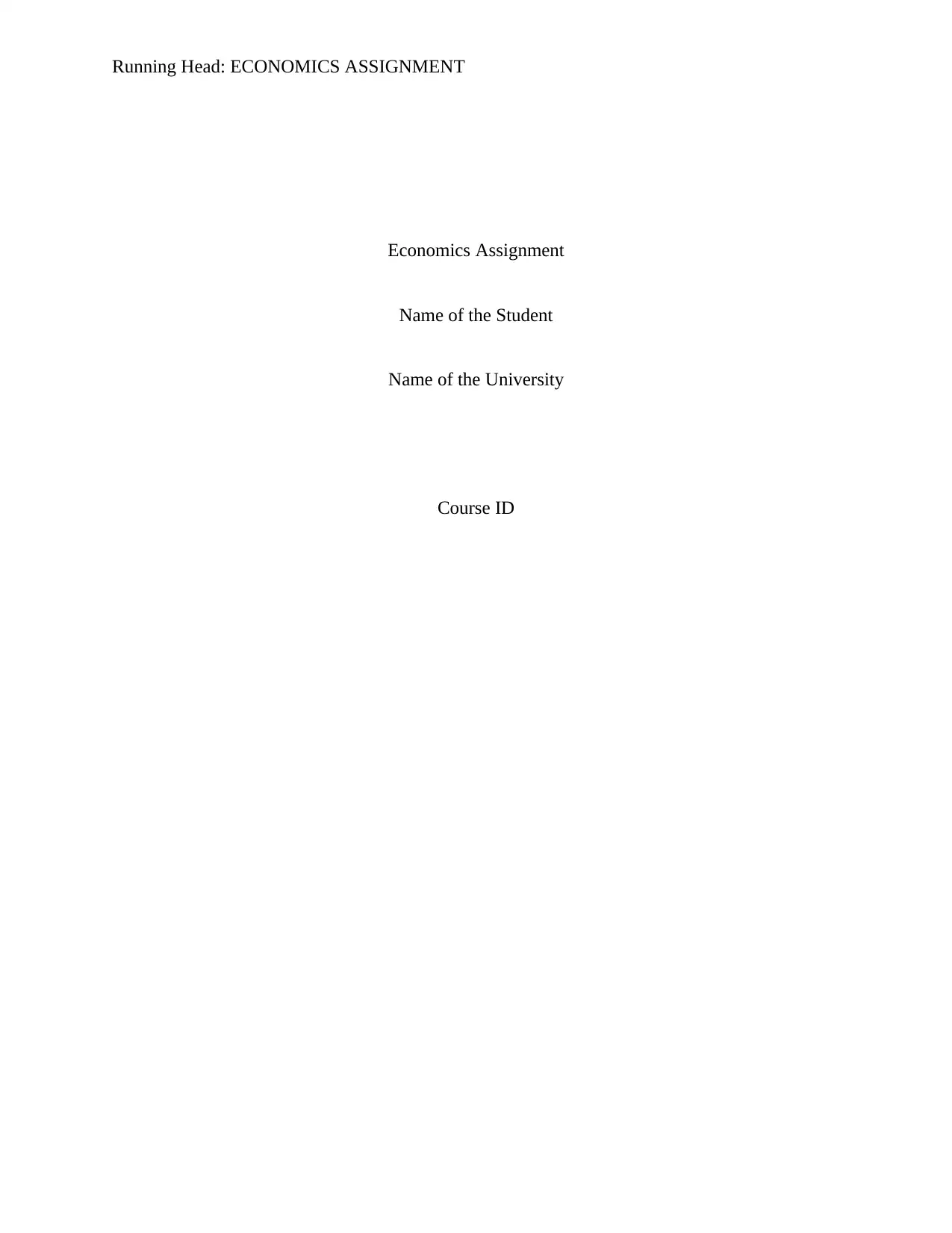
Running Head: ECONOMICS ASSIGNMENT
Economics Assignment
Name of the Student
Name of the University
Course ID
Economics Assignment
Name of the Student
Name of the University
Course ID
Paraphrase This Document
Need a fresh take? Get an instant paraphrase of this document with our AI Paraphraser
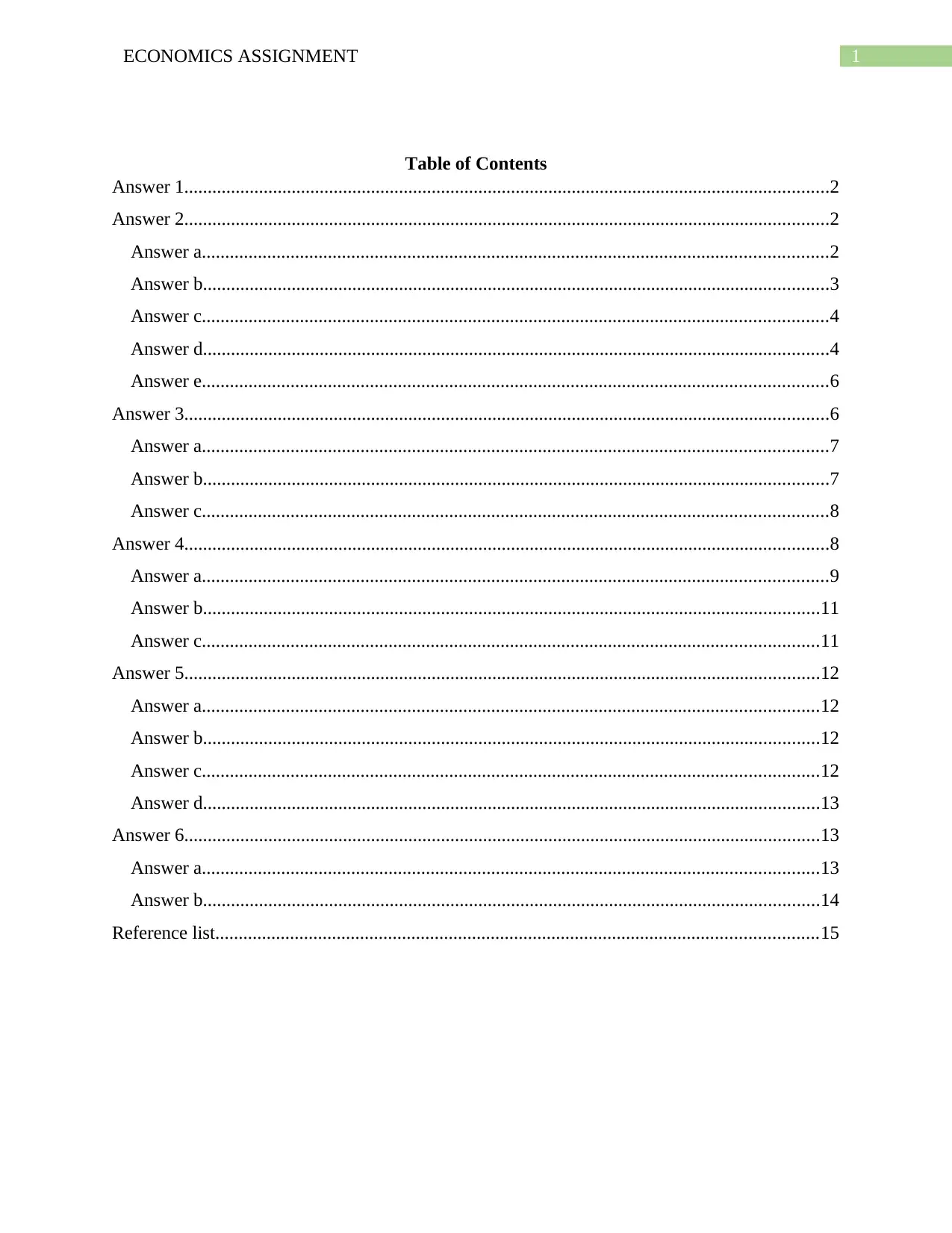
1ECONOMICS ASSIGNMENT
Table of Contents
Answer 1..........................................................................................................................................2
Answer 2..........................................................................................................................................2
Answer a......................................................................................................................................2
Answer b......................................................................................................................................3
Answer c......................................................................................................................................4
Answer d......................................................................................................................................4
Answer e......................................................................................................................................6
Answer 3..........................................................................................................................................6
Answer a......................................................................................................................................7
Answer b......................................................................................................................................7
Answer c......................................................................................................................................8
Answer 4..........................................................................................................................................8
Answer a......................................................................................................................................9
Answer b....................................................................................................................................11
Answer c....................................................................................................................................11
Answer 5........................................................................................................................................12
Answer a....................................................................................................................................12
Answer b....................................................................................................................................12
Answer c....................................................................................................................................12
Answer d....................................................................................................................................13
Answer 6........................................................................................................................................13
Answer a....................................................................................................................................13
Answer b....................................................................................................................................14
Reference list.................................................................................................................................15
Table of Contents
Answer 1..........................................................................................................................................2
Answer 2..........................................................................................................................................2
Answer a......................................................................................................................................2
Answer b......................................................................................................................................3
Answer c......................................................................................................................................4
Answer d......................................................................................................................................4
Answer e......................................................................................................................................6
Answer 3..........................................................................................................................................6
Answer a......................................................................................................................................7
Answer b......................................................................................................................................7
Answer c......................................................................................................................................8
Answer 4..........................................................................................................................................8
Answer a......................................................................................................................................9
Answer b....................................................................................................................................11
Answer c....................................................................................................................................11
Answer 5........................................................................................................................................12
Answer a....................................................................................................................................12
Answer b....................................................................................................................................12
Answer c....................................................................................................................................12
Answer d....................................................................................................................................13
Answer 6........................................................................................................................................13
Answer a....................................................................................................................................13
Answer b....................................................................................................................................14
Reference list.................................................................................................................................15

2ECONOMICS ASSIGNMENT
Answer 1
The share and stock market has characteristic similar to that of a perfectly competitive
market. The stock market presents a global community consisting four different groups such as
public corporation, buyers, sellers and market makers. The shares exchanged in the market are
homogenous. Buyers are able to purchase shares from any sellers and receive the same product.
Like perfectly competitive market, sellers are price takers in the market. Share prices are
determined independently without intervention of buyers and sellers (Taylor et al. 2014). The
behavior of any individual in the market does not affect the market outcome. Buyers and sellers
have complete information in the market. Having this basic assumptions, the BP shareholder
represent a perfectly competitive market.
Answer 2
Answer a
The demand equation in the egg market
P=1000−2 Q
The supply function is given as
P=100+ Q
The equilibrium price and quantity can be determined from equating market demand and market
supply (Mankiw 2017)
Demand=Supply
¿ , 1000−2 Q=100+Q
Answer 1
The share and stock market has characteristic similar to that of a perfectly competitive
market. The stock market presents a global community consisting four different groups such as
public corporation, buyers, sellers and market makers. The shares exchanged in the market are
homogenous. Buyers are able to purchase shares from any sellers and receive the same product.
Like perfectly competitive market, sellers are price takers in the market. Share prices are
determined independently without intervention of buyers and sellers (Taylor et al. 2014). The
behavior of any individual in the market does not affect the market outcome. Buyers and sellers
have complete information in the market. Having this basic assumptions, the BP shareholder
represent a perfectly competitive market.
Answer 2
Answer a
The demand equation in the egg market
P=1000−2 Q
The supply function is given as
P=100+ Q
The equilibrium price and quantity can be determined from equating market demand and market
supply (Mankiw 2017)
Demand=Supply
¿ , 1000−2 Q=100+Q
⊘ This is a preview!⊘
Do you want full access?
Subscribe today to unlock all pages.

Trusted by 1+ million students worldwide
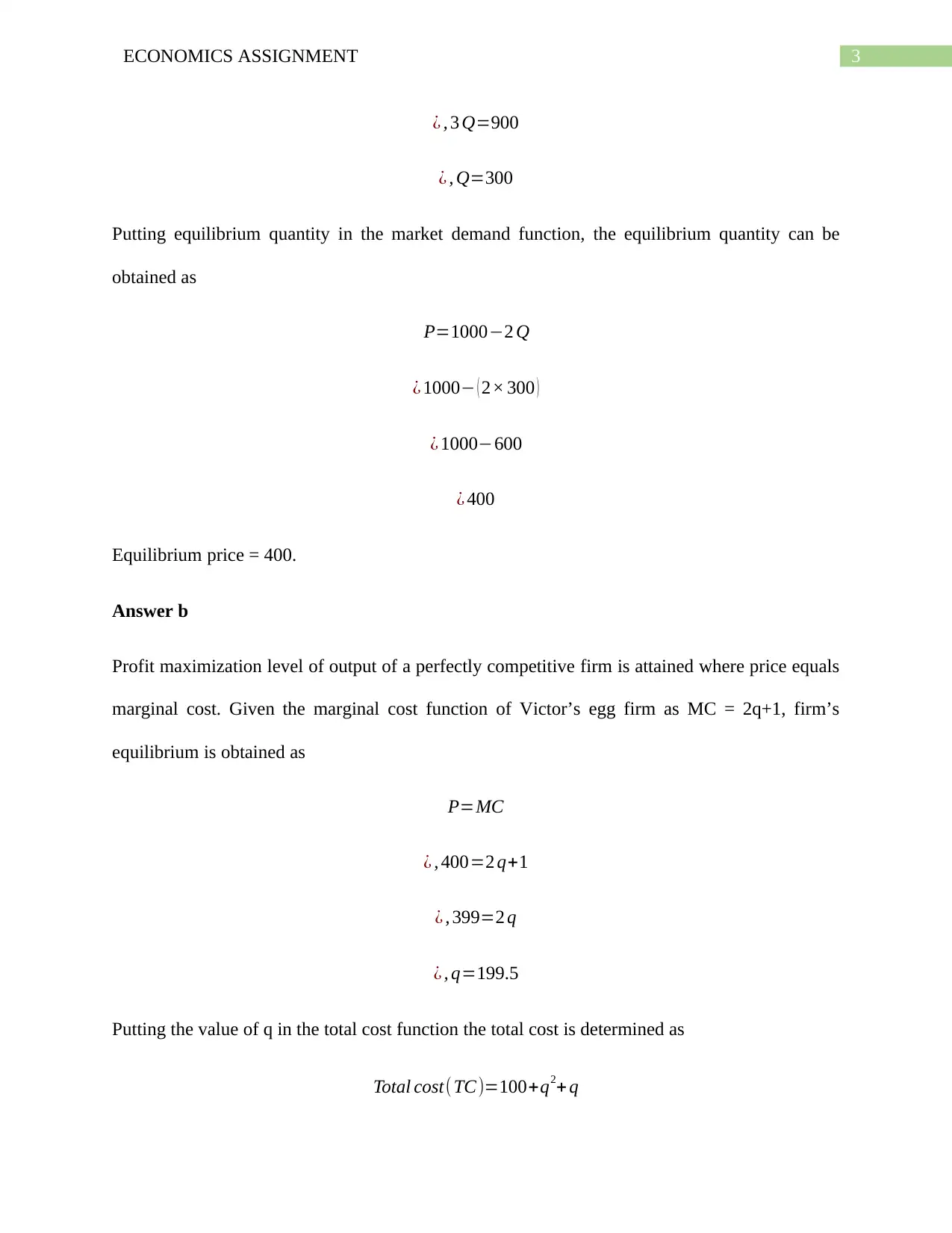
3ECONOMICS ASSIGNMENT
¿ , 3 Q=900
¿ , Q=300
Putting equilibrium quantity in the market demand function, the equilibrium quantity can be
obtained as
P=1000−2 Q
¿ 1000− ( 2× 300 )
¿ 1000−600
¿ 400
Equilibrium price = 400.
Answer b
Profit maximization level of output of a perfectly competitive firm is attained where price equals
marginal cost. Given the marginal cost function of Victor’s egg firm as MC = 2q+1, firm’s
equilibrium is obtained as
P=MC
¿ , 400=2 q+1
¿ , 399=2 q
¿ , q=199.5
Putting the value of q in the total cost function the total cost is determined as
Total cost( TC)=100+q2+ q
¿ , 3 Q=900
¿ , Q=300
Putting equilibrium quantity in the market demand function, the equilibrium quantity can be
obtained as
P=1000−2 Q
¿ 1000− ( 2× 300 )
¿ 1000−600
¿ 400
Equilibrium price = 400.
Answer b
Profit maximization level of output of a perfectly competitive firm is attained where price equals
marginal cost. Given the marginal cost function of Victor’s egg firm as MC = 2q+1, firm’s
equilibrium is obtained as
P=MC
¿ , 400=2 q+1
¿ , 399=2 q
¿ , q=199.5
Putting the value of q in the total cost function the total cost is determined as
Total cost( TC)=100+q2+ q
Paraphrase This Document
Need a fresh take? Get an instant paraphrase of this document with our AI Paraphraser

4ECONOMICS ASSIGNMENT
¿ 100+¿
¿ 40099.75
Total Revenue (TR )=Price ( P ) ×Quantity ( q )
¿ 400 × 199.5
¿ 79800
Profit=TR−TC
¿ 79800−40099.75
¿ 39700.25
Answer c
In the market, there exists a positive economic profit of 39700.25. Under the perfect
competition positive economic profit can only be earned in short run (Ward and Begg 2016).
Thus it describes the short run equilibrium. In the long run, new firms will enter the profit
reducing economic profit to zero.
Answer d
Long run equilibrium price and Quantity
In the long run, competitive firm produces at the minimum point of average total cost.
The averages cost function is given as
ATC=100+q2 +q
q
¿ 100+¿
¿ 40099.75
Total Revenue (TR )=Price ( P ) ×Quantity ( q )
¿ 400 × 199.5
¿ 79800
Profit=TR−TC
¿ 79800−40099.75
¿ 39700.25
Answer c
In the market, there exists a positive economic profit of 39700.25. Under the perfect
competition positive economic profit can only be earned in short run (Ward and Begg 2016).
Thus it describes the short run equilibrium. In the long run, new firms will enter the profit
reducing economic profit to zero.
Answer d
Long run equilibrium price and Quantity
In the long run, competitive firm produces at the minimum point of average total cost.
The averages cost function is given as
ATC=100+q2 +q
q
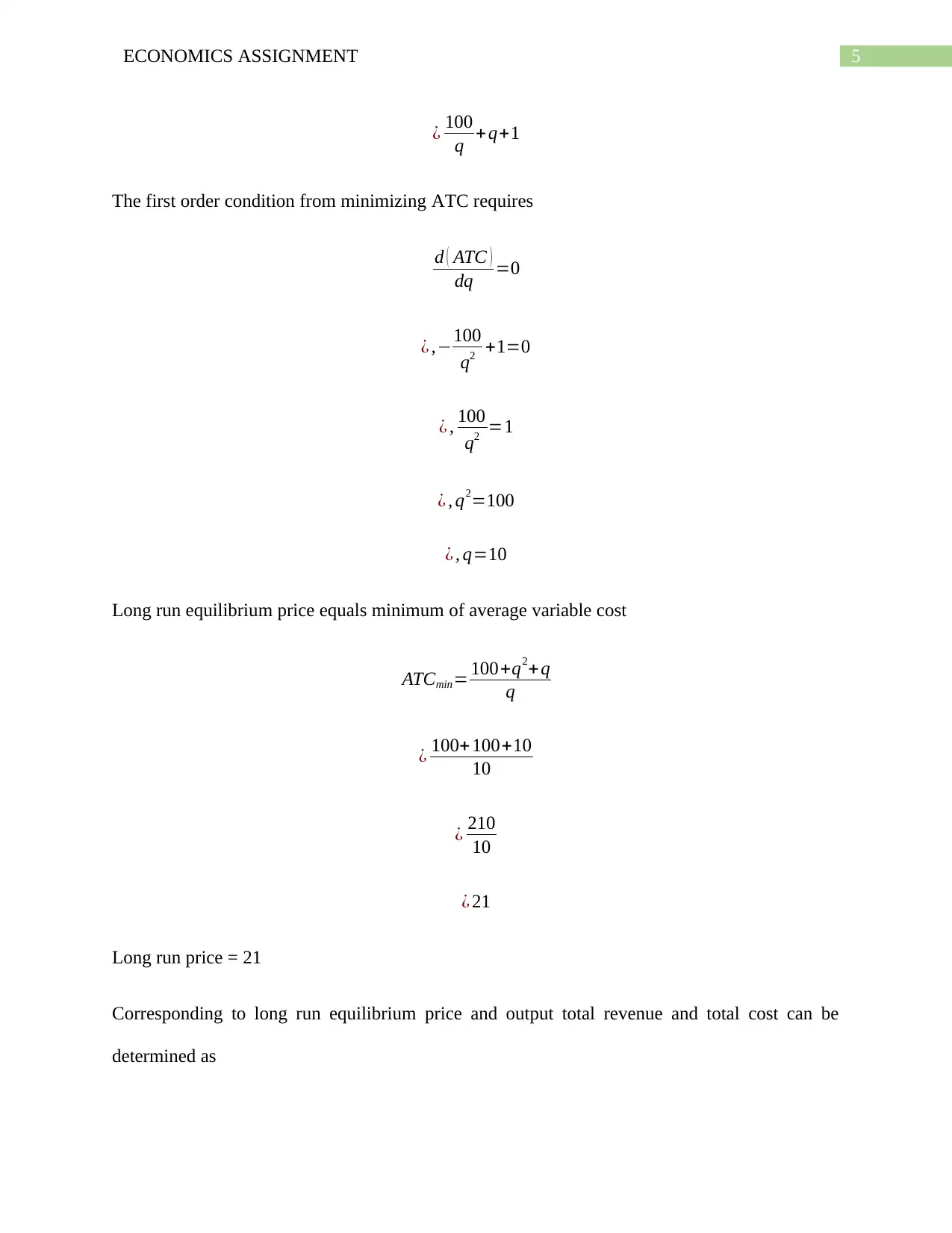
5ECONOMICS ASSIGNMENT
¿ 100
q +q+1
The first order condition from minimizing ATC requires
d ( ATC )
dq =0
¿ ,−100
q2 +1=0
¿ , 100
q2 =1
¿ , q2=100
¿ , q=10
Long run equilibrium price equals minimum of average variable cost
ATCmin= 100+q2+q
q
¿ 100+ 100+10
10
¿ 210
10
¿ 21
Long run price = 21
Corresponding to long run equilibrium price and output total revenue and total cost can be
determined as
¿ 100
q +q+1
The first order condition from minimizing ATC requires
d ( ATC )
dq =0
¿ ,−100
q2 +1=0
¿ , 100
q2 =1
¿ , q2=100
¿ , q=10
Long run equilibrium price equals minimum of average variable cost
ATCmin= 100+q2+q
q
¿ 100+ 100+10
10
¿ 210
10
¿ 21
Long run price = 21
Corresponding to long run equilibrium price and output total revenue and total cost can be
determined as
⊘ This is a preview!⊘
Do you want full access?
Subscribe today to unlock all pages.

Trusted by 1+ million students worldwide
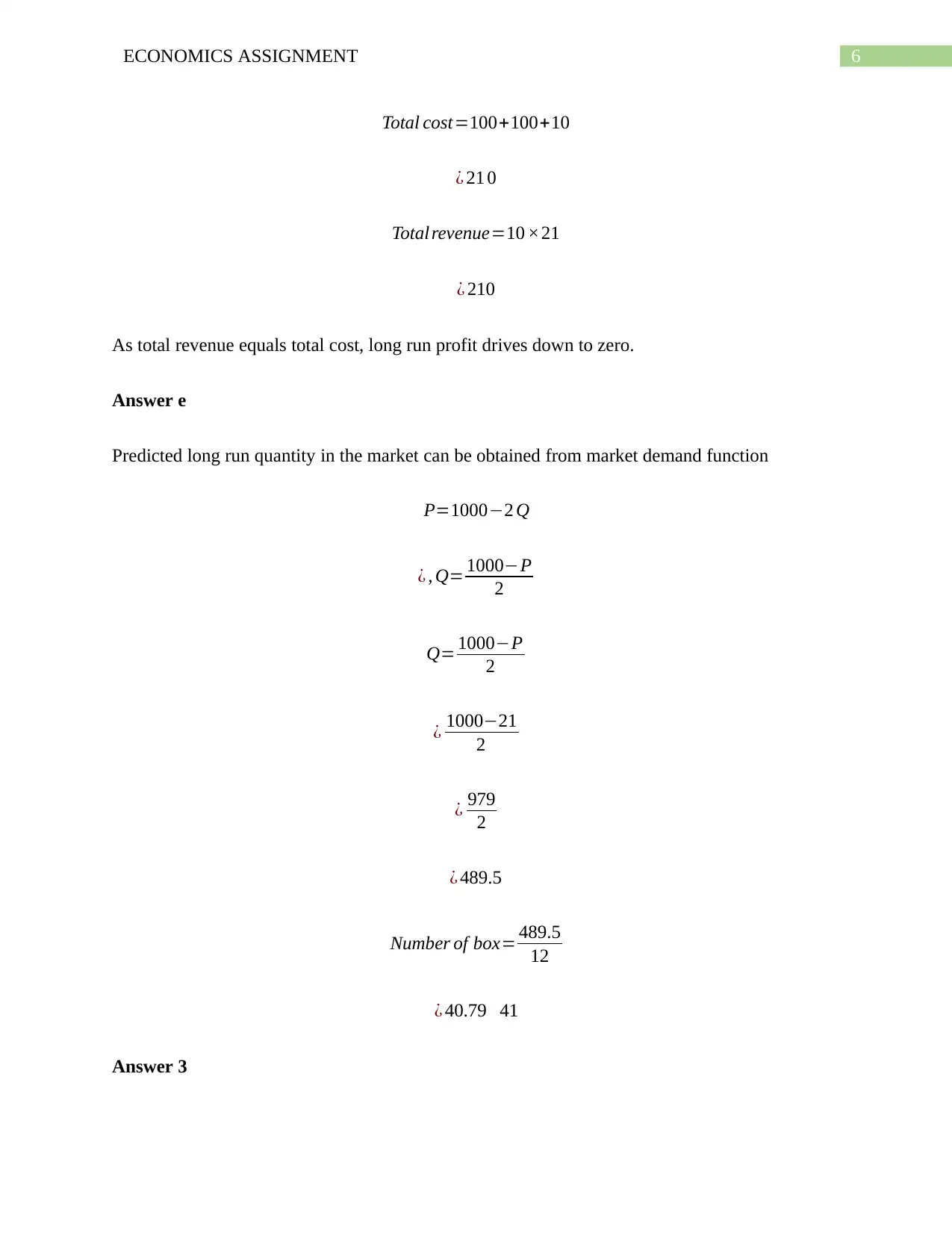
6ECONOMICS ASSIGNMENT
Total cost=100+100+10
¿ 21 0
Total revenue=10 ×21
¿ 210
As total revenue equals total cost, long run profit drives down to zero.
Answer e
Predicted long run quantity in the market can be obtained from market demand function
P=1000−2 Q
¿ , Q= 1000−P
2
Q= 1000−P
2
¿ 1000−21
2
¿ 979
2
¿ 489.5
Number of box= 489.5
12
¿ 40.79 41
Answer 3
Total cost=100+100+10
¿ 21 0
Total revenue=10 ×21
¿ 210
As total revenue equals total cost, long run profit drives down to zero.
Answer e
Predicted long run quantity in the market can be obtained from market demand function
P=1000−2 Q
¿ , Q= 1000−P
2
Q= 1000−P
2
¿ 1000−21
2
¿ 979
2
¿ 489.5
Number of box= 489.5
12
¿ 40.79 41
Answer 3
Paraphrase This Document
Need a fresh take? Get an instant paraphrase of this document with our AI Paraphraser

7ECONOMICS ASSIGNMENT
Answer a
Firms in a perfectly competitive market do not face any barriers to entry or exit the
market. Firms take the decision to enter of exit the industry depending upon the state of
profitability. Consider a situation where perfectly competitive firm in the short run enjoys profit
above the normal profit. The market then seems profitable to other firms (Salvatore and Brooker
2015). In response to high profit new firms enter the market raising market supply. As supply
increases, price as well as profit falls. Entry of new firms erode all the profit leaving only normal
or zero economic profit in the long run.
Answer b
i)
A firm incurring loss must have a price that is lower than its average cost. In the short run despite
making loss, firms continue operation if price is above the minimum average variable cost. In
this situation loss making firm recovers the variable cost and some of its fixed cost. Point where
firms start to make loss is called break-even point (Maurice and Thomas 2015). When price is
above the variable cost then continuing production firms can get a higher outcome as compared
to that from completely shutting down production.
ii)
A firm that decides to shut down operation in the short run should face such a low price that
variable costs cannot be recovered. In this situation it is better for the firm to close down
operation and leave the industry paying its fixed cost. It is the point where price is lower than
minimum average variable cost known as the shut-down point (Perloff and Brander 2016).
Answer a
Firms in a perfectly competitive market do not face any barriers to entry or exit the
market. Firms take the decision to enter of exit the industry depending upon the state of
profitability. Consider a situation where perfectly competitive firm in the short run enjoys profit
above the normal profit. The market then seems profitable to other firms (Salvatore and Brooker
2015). In response to high profit new firms enter the market raising market supply. As supply
increases, price as well as profit falls. Entry of new firms erode all the profit leaving only normal
or zero economic profit in the long run.
Answer b
i)
A firm incurring loss must have a price that is lower than its average cost. In the short run despite
making loss, firms continue operation if price is above the minimum average variable cost. In
this situation loss making firm recovers the variable cost and some of its fixed cost. Point where
firms start to make loss is called break-even point (Maurice and Thomas 2015). When price is
above the variable cost then continuing production firms can get a higher outcome as compared
to that from completely shutting down production.
ii)
A firm that decides to shut down operation in the short run should face such a low price that
variable costs cannot be recovered. In this situation it is better for the firm to close down
operation and leave the industry paying its fixed cost. It is the point where price is lower than
minimum average variable cost known as the shut-down point (Perloff and Brander 2016).
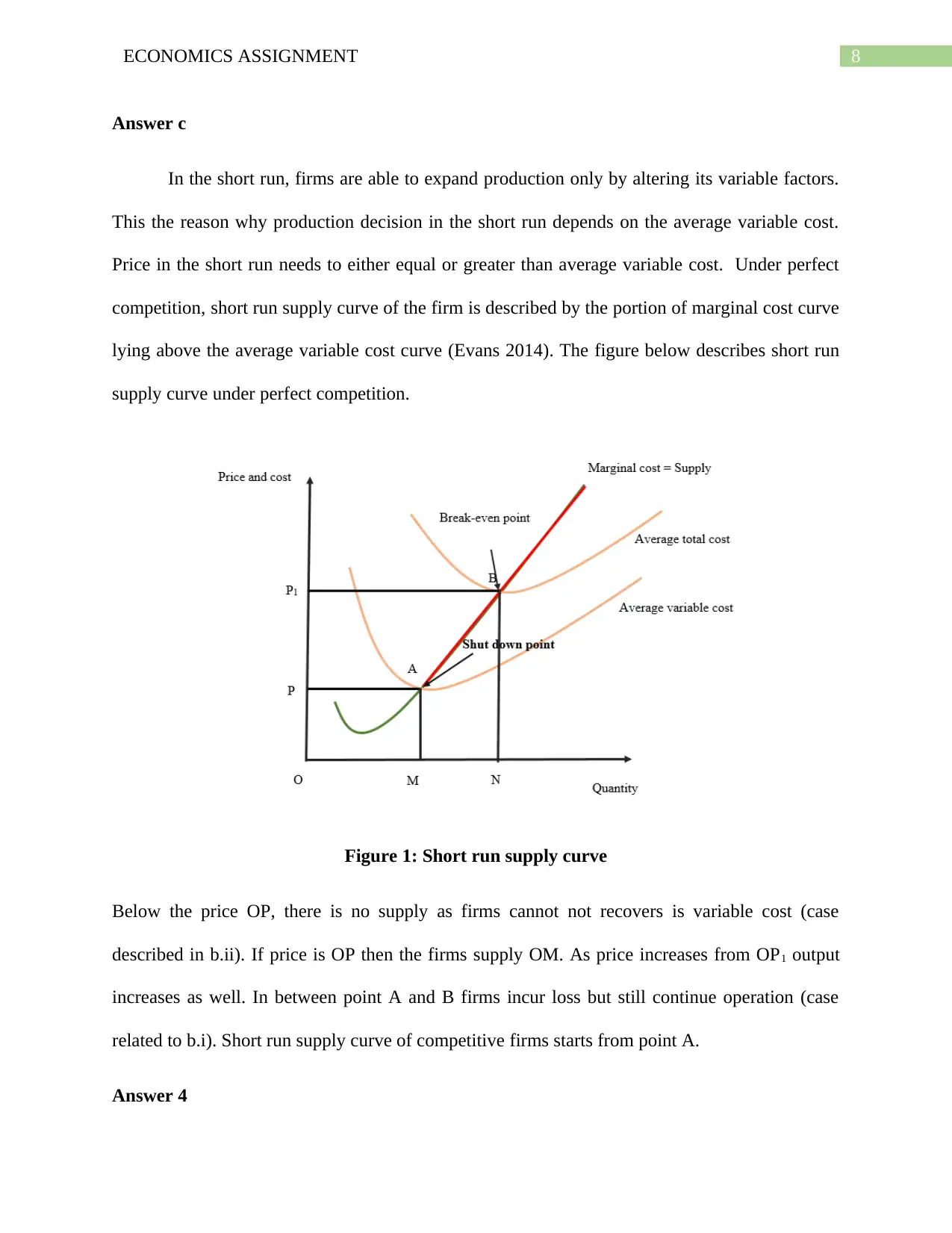
8ECONOMICS ASSIGNMENT
Answer c
In the short run, firms are able to expand production only by altering its variable factors.
This the reason why production decision in the short run depends on the average variable cost.
Price in the short run needs to either equal or greater than average variable cost. Under perfect
competition, short run supply curve of the firm is described by the portion of marginal cost curve
lying above the average variable cost curve (Evans 2014). The figure below describes short run
supply curve under perfect competition.
Figure 1: Short run supply curve
Below the price OP, there is no supply as firms cannot not recovers is variable cost (case
described in b.ii). If price is OP then the firms supply OM. As price increases from OP1 output
increases as well. In between point A and B firms incur loss but still continue operation (case
related to b.i). Short run supply curve of competitive firms starts from point A.
Answer 4
Answer c
In the short run, firms are able to expand production only by altering its variable factors.
This the reason why production decision in the short run depends on the average variable cost.
Price in the short run needs to either equal or greater than average variable cost. Under perfect
competition, short run supply curve of the firm is described by the portion of marginal cost curve
lying above the average variable cost curve (Evans 2014). The figure below describes short run
supply curve under perfect competition.
Figure 1: Short run supply curve
Below the price OP, there is no supply as firms cannot not recovers is variable cost (case
described in b.ii). If price is OP then the firms supply OM. As price increases from OP1 output
increases as well. In between point A and B firms incur loss but still continue operation (case
related to b.i). Short run supply curve of competitive firms starts from point A.
Answer 4
⊘ This is a preview!⊘
Do you want full access?
Subscribe today to unlock all pages.

Trusted by 1+ million students worldwide
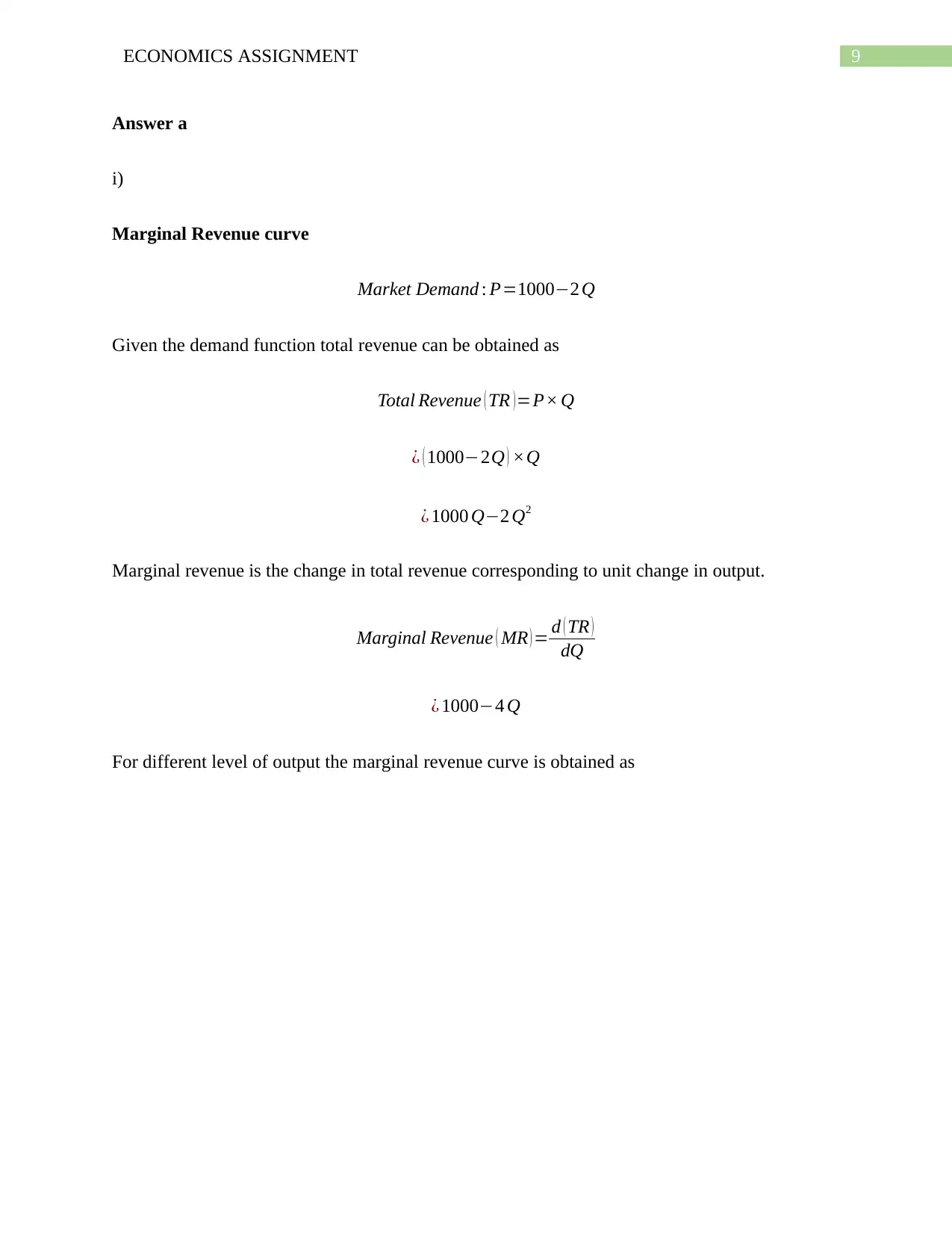
9ECONOMICS ASSIGNMENT
Answer a
i)
Marginal Revenue curve
Market Demand : P=1000−2 Q
Given the demand function total revenue can be obtained as
Total Revenue ( TR )=P× Q
¿ ( 1000−2Q ) ×Q
¿ 1000 Q−2 Q2
Marginal revenue is the change in total revenue corresponding to unit change in output.
Marginal Revenue ( MR ) = d ( TR )
dQ
¿ 1000−4 Q
For different level of output the marginal revenue curve is obtained as
Answer a
i)
Marginal Revenue curve
Market Demand : P=1000−2 Q
Given the demand function total revenue can be obtained as
Total Revenue ( TR )=P× Q
¿ ( 1000−2Q ) ×Q
¿ 1000 Q−2 Q2
Marginal revenue is the change in total revenue corresponding to unit change in output.
Marginal Revenue ( MR ) = d ( TR )
dQ
¿ 1000−4 Q
For different level of output the marginal revenue curve is obtained as
Paraphrase This Document
Need a fresh take? Get an instant paraphrase of this document with our AI Paraphraser

10ECONOMICS ASSIGNMENT
0 50 100 150 200 250 300 350 400 450
-800
-600
-400
-200
0
200
400
600
800
1000
1200
Marginal Revenue
Quantity
Marginal Revenue
Figure 2: Marginal Revenue Curve
ii)
Profit maximization under monopoly
Profit maximization condition of monopolist
MR = MC
1000−4 Q=2Q+1
¿ , 6 Q=999
¿ , Q=166.5
Price charged by the monopolist
Price ( P )=1000−2 Q
¿ 1000− ( 2×166.5 )
¿ 1000−333
0 50 100 150 200 250 300 350 400 450
-800
-600
-400
-200
0
200
400
600
800
1000
1200
Marginal Revenue
Quantity
Marginal Revenue
Figure 2: Marginal Revenue Curve
ii)
Profit maximization under monopoly
Profit maximization condition of monopolist
MR = MC
1000−4 Q=2Q+1
¿ , 6 Q=999
¿ , Q=166.5
Price charged by the monopolist
Price ( P )=1000−2 Q
¿ 1000− ( 2×166.5 )
¿ 1000−333
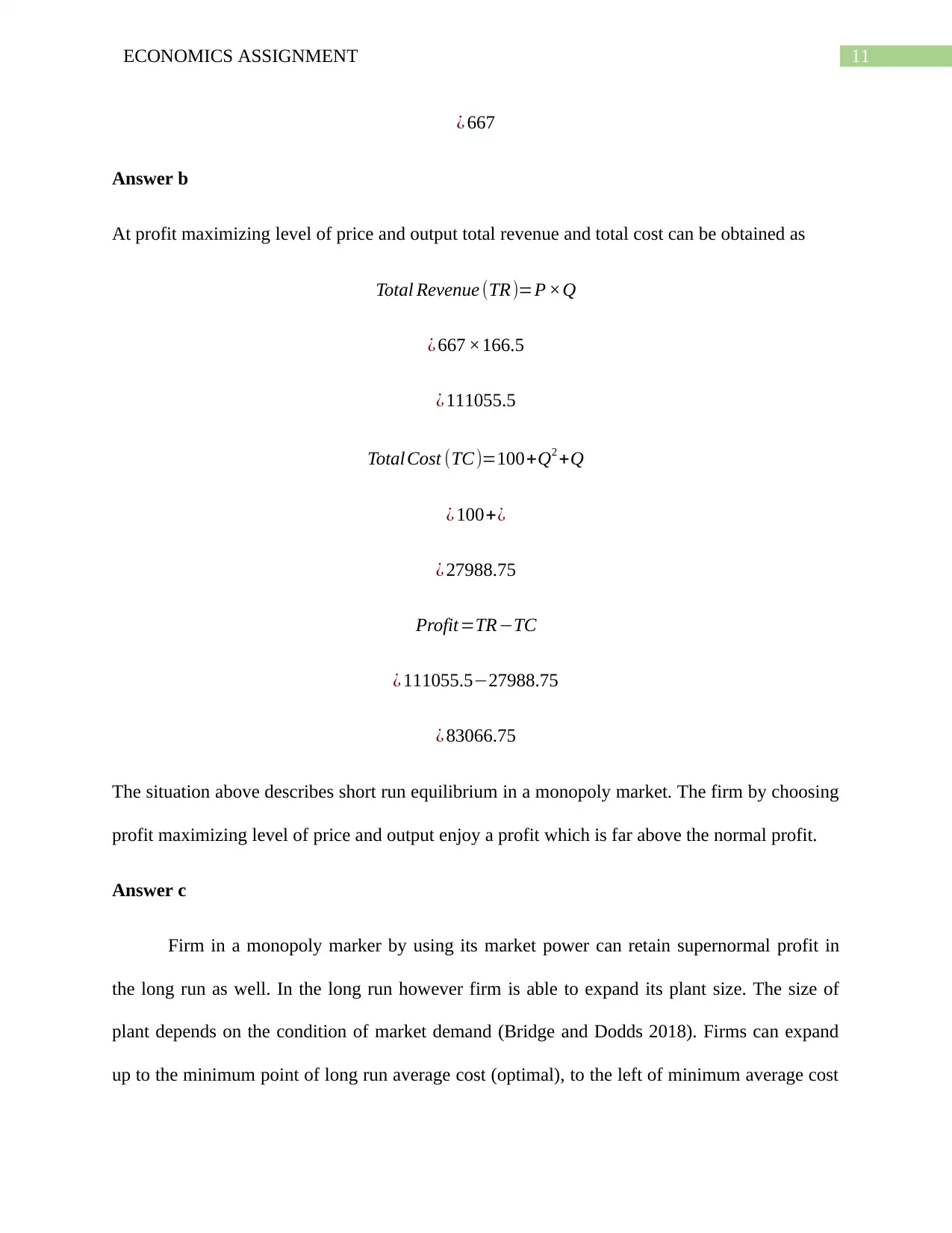
11ECONOMICS ASSIGNMENT
¿ 667
Answer b
At profit maximizing level of price and output total revenue and total cost can be obtained as
Total Revenue (TR)=P ×Q
¿ 667 ×166.5
¿ 111055.5
Total Cost (TC)=100+Q2 +Q
¿ 100+¿
¿ 27988.75
Profit=TR−TC
¿ 111055.5−27988.75
¿ 83066.75
The situation above describes short run equilibrium in a monopoly market. The firm by choosing
profit maximizing level of price and output enjoy a profit which is far above the normal profit.
Answer c
Firm in a monopoly marker by using its market power can retain supernormal profit in
the long run as well. In the long run however firm is able to expand its plant size. The size of
plant depends on the condition of market demand (Bridge and Dodds 2018). Firms can expand
up to the minimum point of long run average cost (optimal), to the left of minimum average cost
¿ 667
Answer b
At profit maximizing level of price and output total revenue and total cost can be obtained as
Total Revenue (TR)=P ×Q
¿ 667 ×166.5
¿ 111055.5
Total Cost (TC)=100+Q2 +Q
¿ 100+¿
¿ 27988.75
Profit=TR−TC
¿ 111055.5−27988.75
¿ 83066.75
The situation above describes short run equilibrium in a monopoly market. The firm by choosing
profit maximizing level of price and output enjoy a profit which is far above the normal profit.
Answer c
Firm in a monopoly marker by using its market power can retain supernormal profit in
the long run as well. In the long run however firm is able to expand its plant size. The size of
plant depends on the condition of market demand (Bridge and Dodds 2018). Firms can expand
up to the minimum point of long run average cost (optimal), to the left of minimum average cost
⊘ This is a preview!⊘
Do you want full access?
Subscribe today to unlock all pages.

Trusted by 1+ million students worldwide
1 out of 16
Related Documents
Your All-in-One AI-Powered Toolkit for Academic Success.
+13062052269
info@desklib.com
Available 24*7 on WhatsApp / Email
![[object Object]](/_next/static/media/star-bottom.7253800d.svg)
Unlock your academic potential
Copyright © 2020–2025 A2Z Services. All Rights Reserved. Developed and managed by ZUCOL.





